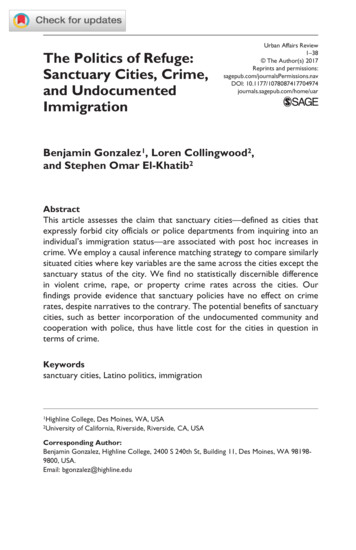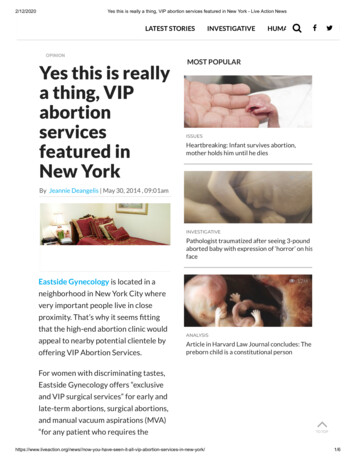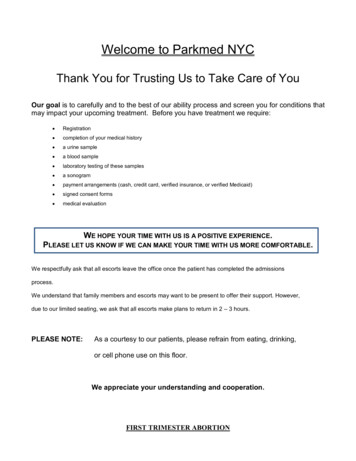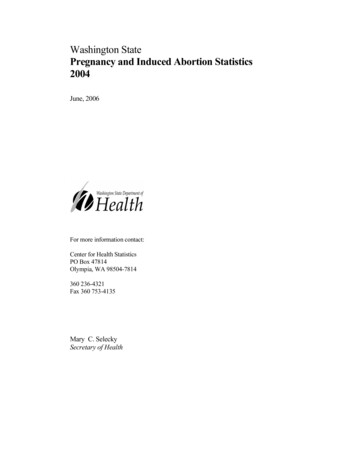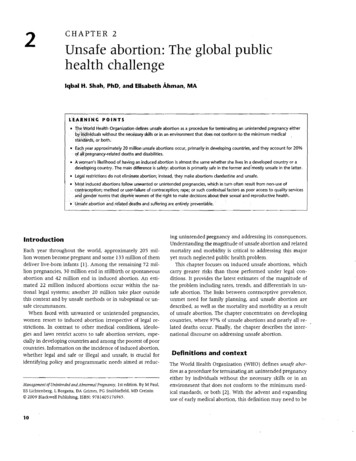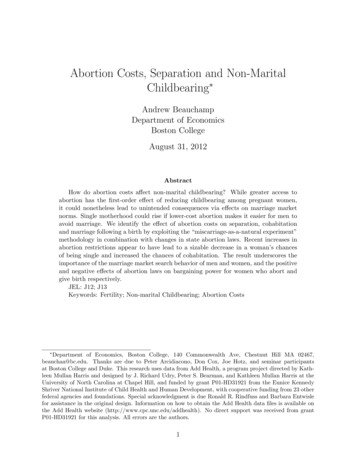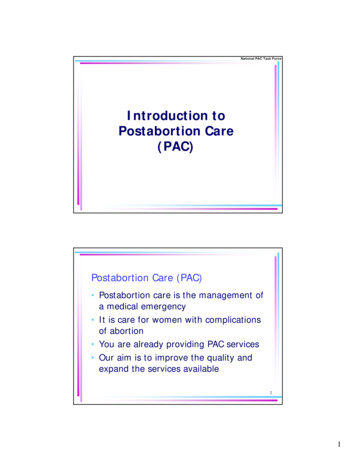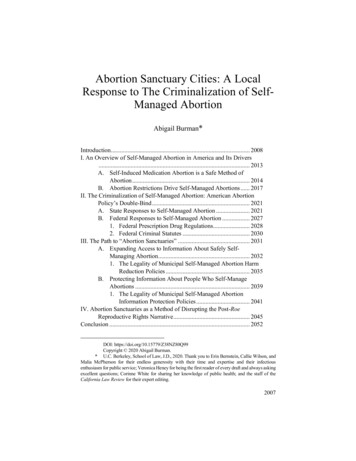
Transcription
Abortion Sanctuary Cities: A LocalResponse to The Criminalization of SelfManaged AbortionAbigail Burman*Introduction. 2008I. An Overview of Self-Managed Abortion in America and Its Drivers. 2013A. Self-Induced Medication Abortion is a Safe Method ofAbortion . 2014B. Abortion Restrictions Drive Self-Managed Abortions . 2017II. The Criminalization of Self-Managed Abortion: American AbortionPolicy’s Double-Bind . 2021A. State Responses to Self-Managed Abortion . 2021B. Federal Responses to Self-Managed Abortion . 20271. Federal Prescription Drug Regulations. 20282. Federal Criminal Statutes . 2030III. The Path to “Abortion Sanctuaries” . 2031A. Expanding Access to Information About Safely SelfManaging Abortion. 20321. The Legality of Municipal Self-Managed Abortion HarmReduction Policies . 2035B. Protecting Information About People Who Self-ManageAbortions . 20391. The Legality of Municipal Self-Managed AbortionInformation Protection Policies . 2041IV. Abortion Sanctuaries as a Method of Disrupting the Post-RoeReproductive Rights Narrative . 2045Conclusion . 2052DOI: https://doi.org/10.15779/Z38NZ80Q99Copyright 2020 Abigail Burman.* U.C. Berkeley, School of Law, J.D., 2020. Thank you to Erin Bernstein, Callie Wilson, andMalia McPherson for their endless generosity with their time and expertise and their infectiousenthusiasm for public service; Veronica Heney for being the first reader of every draft and always askingexcellent questions; Corinne White for sharing her knowledge of public health; and the staff of theCalifornia Law Review for their expert editing.2007
2008CALIFORNIA LAW REVIEW[Vol. 108:2007INTRODUCTIONYou live in Mississippi, work an hourly, minimum wage job, have nosavings, and have young children. You are also seven weeks pregnant and wantto have an abortion.Technically, you can go to an abortion clinic. But even though you haveMedicaid, it won’t cover any of the procedure’s costs because Mississippigenerally follows the federal Hyde Amendment restrictions.1 So not only willyou have to find a provider and schedule an appointment, you will also need tocome up with hundreds of dollars to cover the cost of the procedure, money forgas to get to the clinic an hour from your house, and money to pay someone towatch your kids.2 In addition, Mississippi has a mandatory waiting period and amandatory ultrasound law, so you will need another hundred dollars to pay foran ultrasound, as well as twice the time off work, childcare, and money fortransportation.3 Altogether, going to a clinic to get an abortion could cost youwell over five hundred dollars, the equivalent of more than seventy hours ofwork.4 And if you cannot afford the procedure now, the costs will only go up.5Alternatively, you can safely and effectively induce an abortion usingmisoprostol and mifepristone, two medications that can be ordered online forninety-five dollars, maybe less.6 The medications will be sent directly to yourhome, and you can take them at whatever time is best for you. If you choose this1. State Funding of Abortion Under Medicaid, GUTTMACHER INST. (Aug. 1, perma.cc/YD89-H84T].The Hyde Amendment is an amendment to the federal budget that has been passed everyyear since 1976. It forbids the use of federal funds to pay for an abortion, except for a narrow set ofcircumstances. The current version of the Hyde Amendment exempts cases of rape and incest or thepregnant person’s life being endangered. See Julie Rovner, Clash Over Abortion Hobbles A Health Bill.Again. Here’s How., KAISER HEALTH NEWS (Mar. 21, 2018), health-bill-again-heres-how/ [https://perma.cc/2MYC-6L29].2. See Russell Goldenberg et al., How Far is Too Far? An Analysis of Driving Times toAbortion Clinics in the US, THE PUDDING (Sept. 2017), .cc/99XS-U46K].3. State Facts About Abortion: Mississippi, GUTTMACHER INST. (Mar. facts-about-abortion-mississippi [https://perma.cc/RE2CXQX2].4. Annual Report, DC ABORTION FUND (2017), 01/daf1801-2017annual-report-pc-v5-1.pdf [https://perma.cc/84TF-LQ3G].5. See Charlotte Cowles, How Much Does an Abortion Cost? Learn the Facts, N.Y.MAGAZINE (Nov. 20, 2018), ortion-cost.html[https://perma.cc/6RFH-VLZZ].6. Julia Belluz, Abortions by Mail Are Available Now in the US. Here’s What You Need toKnow, VOX (Oct. 22, 2018), tol [https://perma.cc/6VEQ-UGE8].
2020]ABORTION SANCTUARY CITIES2009route, you will become one of the tens of thousands of Americans who have selfmanaged an abortion.7Although abortion is legal in America, it is not accessible. Self-managedabortion is one way to reconcile this gap. The assumption that abortions happenin clinics have shaped the American debate about abortion, but studies suggestthat tens of thousands of people8 have contemplated or chosen to self-managetheir abortions: attempting to induce abortion without the involvement of aphysician and outside of a clinical setting.9 This number has increased as stateand federal regulations have choked off access to abortion in clinical settings,and there is no sign of this trend reversing.10Self-managed abortion is safe and effective when performed correctly withthe right drugs, like misoprostol and mifepristone. However, without access tothe proper information or resources, people may use unreliable or harmfulmethods to self-induce. Some use dangerous methods, such as getting hit in thestomach, to self-induce.11 Others use methods like herbal remedies or caffeinethat are safe but ineffective.12 While abortion medication can be both safe andeffective if taken in the right doses at certain intervals, not everyone usingabortion medications has access to the necessary instructions.13 When taken7. Julia Belluz, Abortions by Mail: The FDA is Going After Online Pill Providers, VOX (Mar.12, 2019), M7-P6VN].8. While the majority of people who have abortions are women, men and non-binary peoplealso have abortions. Therefore, when discussing the experiences of people who have abortions and theways that cities should interact with those people, this Note uses gender neutral terminology, althoughit retains the language used by researchers and judges when referencing particular studies or opinions.When discussing the politics of abortion access, the phrase “women and other people who may haveabortions” is used to highlight the patriarchal distribution of power within American society. This Note’suse of “women” includes all people who identify in any way with the term women or have a complexidentity that includes woman.9. See Ellen Wulfhorst, Up Aagainst Strict Laws, Texas Women Learn Do-It-YourselfAbortions, REUTERS (May 24, 2016), xasdoityourself-idUSKCN0YF1BC [https://perma.cc/PT5N-SM9Z]; Emily Bazelon, The Dawn of 7LY-VC4X]; Seth Stephens-Davidowitz, The Return of the D.I.Y. Abortion, N.Y.TIMES (Mar. 5, 2016), the-return-of-the-diyabortion.html [https://perma.cc/WYP3-CFEP].10. Molly Redden, After Wave of Anti-Abortion Laws, US Sees Signs of Women Taking DrasticMeasures, GUARDIAN (June 1, 2016), s [https://perma.cc/H22P-HGQM].11. TEX. POL’Y EVALUATION PROJECT, TEXAS WOMEN’S EXPERIENCES ATTEMPTING SELFINDUCED ABORTION IN THE FACE OF DWINDLING OPTIONS 5 (Nov. 17, 2015) [https://perma.cc/HH7J5EAR].12. Id. at 4.13. See Erica Hellerstein, The Rise of the DIY Abortion in Texas, ATLANTIC (June 27, 0/[https://perma.cc/L62R-9CRC].
2010CALIFORNIA LAW REVIEW[Vol. 108:2007incorrectly, both misoprostol and mifepristone can cause excessive bleeding oran incomplete abortion.14Alongside these dangers, people who self-manage their abortions riskcriminalization by the same state and federal legal systems that make it so hardto access abortions in clinical settings. There are twenty-one known instances ofstates arresting people for self-managing their abortions or assisting someoneelse who is self-managing their abortion.15 It is likely that even more cases havenot been publicly reported.16 There have not yet been any federal arrests orprosecutions of people related to self-managed abortion, but both federalprescription drug regulations and federal criminal statutes could be used toprosecute and persecute people who self-manage their abortions.17People who need abortions, particularly those who are low income, thusfind themselves caught betwixt and between. State and federal policies havemade it functionally impossible for them to access an abortion in a clinical settingbut federal and state policies also criminalize self-managed abortion, and it isdifficult to find information about how to self-manage safely. Their right tochoose is reduced to a choice between bad options.Cities are ideally placed to respond to this quandary.18 Health care is a corelocal function, and local governments frequently take on public healthresponsibilities.19 As the Supreme Court has recognized, cities have a wellestablished interest in the health of their residents.20 This interest extends toabortion. Both unsafe abortions and lack of access to abortion negatively impactpregnant people’s health.21 In fact, some localities already acknowledge that14. See id.15. Belluz, supra note 6.16. Id.17. See infra Part II.B.18. This article uses “city” and “locality” interchangeably to refer to local units of government,a category which may also include villages, towns, and counties.19. See Erin B. Bernstein, Health Privacy in Public Spaces, 66 ALA. L. REV. 989, 1015 (2015).20. See id. at 1016.21. See Caitlin Gerdts et al., Side Effects, Physical Health Consequences, and MortalityAssociated with Abortion and Birth After an Unwanted Pregnancy, 26 WOMEN’S HEALTH ISSUES 55,55 (2016) (“The risk of mortality from childbirth in the United States is estimated to be 14 times higherthan the risk from induced abortion, and the risk of all maternal morbidities, defined as ‘conditions eitherunique to pregnancy or potentially exacerbated by pregnancy that occurred in at least 5% of allpregnancies’ is significantly higher among women who give birth than among those who haveabortions.”); Lauren J. Ralph et al., Self-reported Physical Health of Women Who Did and Did NotTerminate Pregnancy After Seeking Abortion Services: A Cohort Study, ANNALS OF INTERNALMEDICINE 9 (2019) (comparing the health of women who successfully obtained abortions and womenwho successfully sought abortions and women who sought abortions but were turned away because ofgestational limits and finding that “for several dimensions of physical health, including overall self-ratedhealth, women denied access to a wanted abortion reported worse long-term physical health than thosewho received abortion”); David A. Grimes et al., Unsafe Abortion: the Preventable Pandemic, 368LANCET 1908, 1908 (2006) (finding that worldwide, 68,000 women die each year as a result of unsafeabortion, defined as “a procedure for terminating an unintended pregnancy either by individuals withoutthe necessary skills or in an environment that does not conform to minimum medical standards, or both.”
2020]ABORTION SANCTUARY CITIES2011abortion is squarely within their interests by providing abortions at their publichealth facilities.22 A number of other states’ and cities’ public health departmentsprovide information, referrals, and other services to both pregnant people andabortion providers.23 Put bluntly, abortion is health care, and cities areresponsible for public health. Cities should support people who self-manage theirabortions because it is their duty to do so.Underlying their interest in public health and abortion access is the fact thatcities are where abstract rights become concrete and accessible. Cities are theform of government most embedded in people’s daily lives. They pave the streetstheir residents walk on, collect their trash, and govern their businesses. Citiesalso take a uniquely pragmatic approach to governance.24 More than state andnational governments, cities must be directly responsive to the needs of theirresidents, cutting across traditional political divides.25 As a result, cities arewhere “the constitutional rubber meets the road.”26 They are often where rights,including the human right27 to an abortion, move from theory to somethingpeople either have or do not have.To that end, this Note proposes two types of policies that cities that wish toprotect the wellbeing of residents who self-manage their abortions canImportantly, unsafe abortion is not synonymous with illegal abortion, nor is safe abortion synonymouswith legal abortion).22. See, e.g., Alameda County Public Health Department, Abortion Providers, L3-YHD3]; Aaron Weinberg, Skagit Regional Health Expanding AbortionServices after Lawsuit, GOSKAGIT (Aug. 2, 2017), https://www.goskagit.com/news/local ices-after-lawsuit/article 42257605-81b5-5d92-b4d819f3cd29a117.html [https://perma.cc/C37M-5UTD]. See also Nancy F. Berglas et al., Approaches,Barriers, and Facilitators to Abortion-related Work in U.S. Health Departments: Perspectives ofMaternal and Child Health and Family Planning Professionals, BMC PUBLIC HEALTH 1, 7 (2020)(“Other department-initiated abortion activities focused on expanding clinical services, including:providing abortion services in department outpatient clinics and hospitals, improving the quality of postabortion contraceptive care, working with community health centers to expand access to medicationabortion, and planning for potential increases in abortion patient volume if neighboring states enactrestrictive abortion policies.”).23. Berglas, supra note 22, at 2.24. See BENJAMIN R. BARBER, IF MAYORS RULED THE WORLD: DYSFUNCTIONAL NATIONS,RISING CITIES 4 (2013).25. See id.; Jill E. Habig & Joanna Pearl, Cities as Engines of Justice, 45 FORDHAM URB. L. J.1159, 1190 (2018).26. See Bernstein, supra note 19, at 1014. See also Habig & Pearl, supra note 25, at 1189–90;Kaitlin Ainsworth Caruso, Associational Standing for Cities, 47 CONN. L. REV. 59, 87 (2014). Seegenerally URBAN JUSTICE (Barbara M. Oomen et al. eds., 2016).27. Part V addresses the rationale for framing abortion as human right rather than aconstitutional one in the American context. International human rights bodies have long recognized thataccess to safe abortion is essential to women’s rights to life and health. See Patty Skuster, How LawsFail the Promise of Medical Abortion: A Global Look, 18 GEO. J. GENDER & L. 379, 381 (2017).Additionally, the reproductive justice framework developed by activists of color emphasizes abortion’simportance to women’s human rights. Kimala Price, What Is Reproductive Justice? How Women ofColor Activists Are Redefining the Pro-Choice Paradigm, 10 MERIDIANS 42, 47 (2010).
2012CALIFORNIA LAW REVIEW[Vol. 108:2007implement. First, cities can use a harm reduction approach—acknowledging thatpeople are self-managing abortions and providing the information necessary forthem to do so safely. Building on the experience of pro-choice activists in LatinAmerican and U.S. cities’ experience applying harm reduction principles inresponse to the opioid crisis, cities should expand access to information aboutsafely self-managing abortion. Second, drawing on the tactics of the immigrationsanctuary movement, cities can adopt policies that limit the spread ofinformation about individuals who choose self-managed abortion to state andfederal authorities, limiting those individuals’ exposure to legal risk.Cities must shape each of these policies to their specific legal context. Theharm reduction policies, in particular, may expose municipal officials to criminalaccomplice liability, and information protection policies, if not carefully craftedand administered, might constitute obstruction of justice. Both policies wouldalso have to contend with state and federal preemption concerns. However, thepossibility of litigation alone should not dissuade cities from pursuing thesepolicies. Some of the anti-abortion laws that might stand in the way of thesepolicies are relatively untested and are vulnerable to legal challenges.28Additionally, as the example of the immigration sanctuary movement shows,cities have a strikingly strong ability to resist federal action, and that capacity forresistance may also carry over, albeit in a more limited capacity, to theirrelationships with their states, particularly on issues of public health. Both thesepolicy proposals and the litigation that might result from them should be viewedas part of an ongoing, mutable conversation about the ways that cities can protectthe rights and wellbeing of their residents and the importance of abortion to theability of women and other people who may have abortions to direct their ownlives and fully participate in their communities.This Note’s final Section explores that conversation, moving from thepractical to the strategic and considering the importance of reimagining both theroots of the right to abortion and the obligations that right places on policymakers. It argues that in addition to their immediate practical benefits, thesepolicies would also offer a much-needed alternative to the dominant post-Roe v.Wade analytic framework of American pro-choice activism. The reasoning ofRoe obscures both the importance of abortion access to women and other peoplewho may have abortions and their ability to make decisions about their own lives,while the emphasis on privacy and the continuing constitutionality of abortionremove the urgency of government action to expand access to abortion. Incontrast, local action to safeguard people who undertake self-managed abortionwould center the needs of people who actually have abortions and place28. Farah Diaz-Tello et al., Roe’s Unfinished Promise: Decriminalizing Abortion Once and ForAll, SIA LEGAL TEAM (2018), [https://perma.cc/K8MJ-EU7Q].
2020]ABORTION SANCTUARY CITIES2013governments in the position of affirmatively expanding access to abortionbeyond the boundaries set by Roe. The policies proposed by this Note positionsaccess to abortion as a human right—vital to women and other people who mayhave abortion’s ability to participate in their own lives and the lives of theircommunities and indivisible from cities’ broader commitment to their residents’welfare.I.AN OVERVIEW OF SELF-MANAGED ABORTION IN AMERICA AND ITS DRIVERSSelf-managed abortion, also called self-induced abortion, is “[t]he practiceof self-administering pharmaceutical pills, traditional herbs, or other means,”with the goal of ending a pregnancy.29 Self-managed abortion—whether throughoverwhelmingly safe methods such as the appropriate use of medication or otherriskier, less effective means—has always been part of the history of abortion.Additionally, studies have repeatedly shown that self-managed abortion, whilerarely publicly discussed, is widespread in America.30 In 2015, American womenperformed more than 700,000 Google searches related to ending their ownpregnancies,31 and researchers used the result of a 2015 study of Texas womento estimate that in Texas alone at least 100,000 women have attempted to selfinduce abortion.32 This Section provides an overview of the methods that peopleuse to induce abortion and of the way that state and federal policies underliepeople’s decision to self-manage their abortions.The safest and most effective method of self-managed abortion, which isalso the method most targeted by state and federal enforcement actions, ismedical abortion using misoprostol either alone or in combination withmifepristone. Studies have shown that pregnant people can safely self-administerboth drugs, making self-managed medication abortion as safe as a medicationabortion performed in a clinical setting. Additionally, medication abortion is29. Jill E. Adams & Melissa Mikesell., Primer on Self-Induced Abortion, SIA LEGAL perma.cc/3GEB-3SBZ].30. Contrary to the stereotype of the “back-alley butcher” killing desperate women in thedecades before Roe legalized abortion, most botched abortions were the result of women attempting toself-abort. Rickie Solinger, Pregnancy and Power Before Roe v. Wade, 1950-1970, in ABORTIONWARS: A HALF CENTURY OF STRUGGLE, 1950-2000 4 (Ricky Solinger ed., 1998).31. Stephens-Davidowitz, supra note 9.32. DAVID GROSSMAN ET AL., KNOWLEDGE, OPINION AND EXPERIENCE RELATED es/publications/TxPEP on Research%20Brief on data suggests that a significant portion of attempts to self-induce may besuccessful. In states with restrictive abortion laws, the number of reported live births is lower than thenumber of reported abortions alone can account for. More research is needed but is possible that someof this gap is due to self-induced abortion. See Stephens-Davidowitz, supra note 9.
2014CALIFORNIA LAW REVIEW[Vol. 108:2007significantly safer and more reliable than other self-managed abortion methods,with the availability of medication abortion having been shown to dramaticallyreduce the incidence of abortion-related injuries.The prevalence of self-managed abortion is inextricable from obstacles thatgovernments and the health care system place in front of people seekingabortions in clinical settings. While abortion remains legal nationwide, apatchwork of state laws and regulations limit the number of clinics and providerswho can provide abortions, forcing pregnant people to jump over medicallyunnecessary hurdles to access abortions within a medical setting. The burdens ofstates’ abortion restrictions are not evenly distributed. Low-income people andpeople of color are disproportionately impacted by anti-abortion laws. People ofcolor are both more likely to seek abortion care and more likely to struggle toafford it.33 Additionally, the majority of women enrolled in Medicaid, whichinsures a third of low-income adults,34 only have coverage for abortion in casesof life endangerment, rape, or incest.35 Weathering state and federal abortionrestrictions to access abortion in a clinical setting requires financial resources,which White people with higher incomes are more likely to have. In light of allthese barriers, it is unsurprising that some pregnant people view self-managedabortion as their best option.A. Self-Induced Medication Abortion is a Safe Method of AbortionPeople attempting to self-induce abortions report using a wide variety ofmethods, some of which risk lasting physical harm. A woman who distributesmisoprostol and mifepristone in the United States reported one woman askingher “if I knew how, exactly, it was that you went about using a wire hanger toabort.”36 People trying to self-manage their abortions have also reported lookinginto physical trauma or drinking household chemicals such as turpentine.37 Other33. J. KOTTING & G.E. ELY, NATIONAL NETWORK OF ABORTION FUNDS, THE UNDUEBURDEN OF PAYING FOR ABORTION: AN EXPLORATION OF ABORTION FUND CASES 6 ofAbortion-Funds.pdf [https://perma.cc/TCV4-LTZ9].34. Health Insurance Coverage of Low Income Adults 19-64 (Under 200% FPL), KAISER ndicator/low-incomeadults/?currentTimeframe 0&sortModel %7D [https://perma.cc/GV3U-5V7G].35. Alina Salganicoff et al., Coverage for Abortion Services in Medicaid, Marketplace Plansand Private Plans, KAISER FAM. FOUND. (June 24, 2019), 6GS-RJ26].36. Anonymous, I Help Desperate Women, and I Could Go To Jail for It, JEZEBEL (Sept. /perma.cc/TEU4-D8DL].37. See Abigail R.A. Aiken et al., Motivations and Experiences of People Seeking MedicationAbortion Online in the United States, 50 PERSP. ON SEXUAL AND REPROD. HEALTH 157, 161 (2018);Molly Redden, ‘Please, I Am out of Options’: Inside the Murky World of DIY Abortions, GUARDIAN
2020]ABORTION SANCTUARY CITIES2015methods of self-induction are safer but ineffective. In a study of self-managedabortion in Texas, multiple women reported taking herbs, teas, caffeine, seeds,and vitamin C in the hopes of inducing an abortion.38However, there is one method of self-inducing an abortion that is, whenused correctly, both as safe and as effective as an abortion performed in a clinalsetting: medication abortion. To self-induce a medication abortion, a persontakes a drug called misoprostol—which is also sold as an ulcer medication underthe name Cytotec—either alone or in combination with another drug calledmifepristone.39 Misoprostol prepares the cervix for labor and causescontractions, while mifepristone blocks production of progesterone, which isnecessary for a pregnancy to continue.40 Although misoprostol is most effectivewhen used in combination with mifepristone, mifepristone’s only use is as anabortifacient, making it harder to obtain.41 Within the first nine weeks ofpregnancy misoprostol alone is 90 percent effective.42The only difference between a self-managed medication abortion usingscientifically backed instructions and a medication abortion performed in a clinicis the lack of an ultrasound to screen for ectopic pregnancy. However, it is notmedically necessary to have an ultrasound before a medication abortion. TheWorld Health Organization, the American College of Obstetricians andGynecologists, and the Royal College of Obstetricians and Gynecologists allspecifically do not suggest performing ultrasound screens for ectopic pregnancyon people seeking abortions unless they have risk factors or symptoms.43 Thusthe two procedures—self-administered medication abortion and medicationabortion under the supervision of a medical provider—are functionallyidentical.44(Nov. 21, 2016), me-abortions-emails-secretworld [https://perma.cc/FCY2-C6XM].38. TEX. POL’Y EVALUATION PROJECT, supra note 11, at 4.39. WORLD HEALTH ORGANIZATION, SAFE ABORTION: TECHNICAL AND POLICY who.int/reproductivehealth/publications/unsafe GC9].40. Becky Little, The Science Behind the “Abortion Pill,” SMITHSONIAN MAG. (June 23, /perma.cc/8CRE-QNYS]; Center for Drug Evaluation and Research, Questions and Answers onMifeprex, FOOD & DRUG ADMIN. (Apr. 9, 2019), wers-mifeprex [https://perma.cc/D5AX-4AYG].41. WORLD HEALTH ORGANIZATION, supra note 39, at 45.42. Id.43. Additionally, less than 1 percent of pregnant people seeking an abortion have ectopicpregnancies, significantly less than the overall rate of ectopic pregnancy. Elizabeth G. Raymond et al.,Reaching Women Where They Are: Eliminating the Initial in-Person Medical Abortion Visit, 92CONTRACEPTION 190, 191 (2015).44. See Raymond et al., supra note 43, at 191; Olga Khazan, Illegal Abortion Will MeanAbortionByMail,ATLANTIC(July18,2018),
2016CALIFORNIA LAW REVIEW[Vol. 108:2007The availability of medication abortion has upended the assumption thatthe only safe abortions are those abortions performed in a clinic by medicalprofessionals.45 When pregnant people are given information about the correctdosage and side effects, they can effectively self-administer abortionmedications and, even more importantly, identify when they are in distress andseek appropriate medical attention. In a study of Irish and Northern Irish women
transportation.3 Altogether, going to a clinic to get an abortion could cost you well over five hundred dollars, the equivalent of more than seventy hours of work.4 And if you cannot afford the procedure now, the costs will only go up.5 Alternatively, you can safely and effectively induce an abortion using
